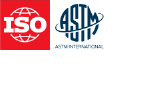Abstract
This practice covers the preparation and use of semiadiabatic calorimetric dosimetry systems for measurement of
absorbed dose and for calibration of routine dosimetry systems when irradiated with electrons for radiation processing applications.
The calorimeters are either transported by a conveyor past a scanned electron beam or are stationary in a broadened
beam.
This document is one of a set of standards that provides recommendations for properly implementing dosimetry in radiation processing, and describes a means of achieving compliance with the requirements of ISO/ASTM Practice
52628 for a calorimetric dosimetry system. It is intended to be read in conjunction with ISO/ASTM Practice 52628.
The calorimeters described in this practice are classified as Type II dosimeters on the basis of the complex effect of influence quantities. See ISO/ASTM Practice 52628.
This practice applies to electron beams in the energy range from 1.5 to 12 MeV.
The absorbed dose range depends on the calorimetric absorbing material and the irradiation and measurement conditions. Minimum dose is approximately 100 Gy and maximum dose is approximately 50 kGy.
The average absorbed-dose rate range shall generally be greater than 10 Gy·s-1.
The temperature range for use of these calorimetric dosimetry systems depends on the thermal resistance of the calorimetric materials, on the calibration range of the temperature sensor, and on the sensitivity of the measurement device.
This standard does not purport to address all of the safety concerns, if any, associated with its use. It is the responsibility of the user of this standard to establish appropriate safety, health, and environmental practices and determine the applicability of regulatory limitations prior to use.
This international standard was developed in accordance with internationally recognized principles on standardization established in the Decision on Principles for the Development of International Standards, Guides and Recommendations issued by the World Trade Organization Technical Barriers to Trade (TBT) Committee.
Life cycle
-
Previously
WithdrawnISO/ASTM 51631:2013
-
Now

